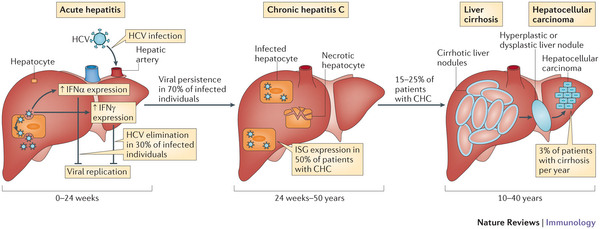Page Contents
- 1 WHAT IS IT?
- 2 WHAT CAUSES IT?
- 3 WHY IS IT CONCERNING MEDICALLY?
- 4 WHAT IS THE INTIAL PRESENTATION?
- 5 WHAT ARE IMPORTANT ELEMENTS OF THE MEDICAL HISTORY?
- 6 WHAT ARE IMPORTANT FEATURES OF THE PHYSICAL EXAM?
- 7 CLINICAL WORKUP: SERUM STUDIES
- 8 HOW DO WE NARROW THE DIFFERENTIAL?
- 9 WHAT IS OUR THRESHOLD FOR DIAGNOSING THIS CONDITION?
- 10 PATIENT MANAGEMENT: DISEASE TREATMENT
- 11 PATIENT MANAGEMENT: PROPHYLACTIC MEASURES
- 12 COULD THIS HAVE BEEN PREVENTED?
- 13 ARCHIVE OF STANDARDIZED EXAM QUESTIONS
WHAT IS IT?
Hepatitis C infection is a viral infection of the liver.
WHAT CAUSES IT?
This condition is caused by the hepatitis C virus (HCV).
WHY IS IT CONCERNING MEDICALLY?
HCV preferentially infects the hepatocytes of the liver leading to their damage (and subsequent inflammation of the liver). This can ultimately result in fibrosis of the liver (cirrhosis), and the impaired ability of the liver to conduct its usually physiological tasks (such as conjugating bilirubin). Furthermore, HCV infection increases the risk for hepatocellular carcinoma.

WHAT IS THE INTIAL PRESENTATION?
Patient Chief Complaints:
- Acute hepatitis: symptoms occur ~ 7 weeks post exposure, and can last 2-12 weeks in duration .
- Fever
- Abdominal pain
- Nausea/vomiting
- Fatigue
- Anorexia
- Chronic hepatitis: symptoms of acute hepatitis (above) can redevelop in chronic hepatitis
- Often asymptomatic
Detected Medical Problems:
- Jaundice
WHAT ARE IMPORTANT ELEMENTS OF THE MEDICAL HISTORY?
Risk Factors:
- IV drug usage
- Transfusion using unscreened blood
- Tattoo parlor usage
Medical History:
WHAT ARE IMPORTANT FEATURES OF THE PHYSICAL EXAM?
Vital Signs:
- Fever: this can be present under certain circumstances (such as acute hepatitis)
Abdominal Exam:
- Hepatomegaly can be appreciated sometimes
- Splenomegaly can be appreciated sometimes
Dermatological Exam:
- Vesicles/erosions may be present on sun exposed areas (such as the back of the hand). This is because patients infected with HCV commonly also have porphyria cutanea trade (PCT)
- Healed lesions (hyperpigmented) can also sometimes be appreciated in these patients (due to past eruptions of PCT)
CLINICAL WORKUP: SERUM STUDIES
Complete Metabolic Panel (CMP): this study can demonstrate the presence of…
- Bilirubinemia: can be direct/indirect/mixed
- Elevated liver enzymes: ALT and AST may be elevated.
Anti-HCV Serology:
- Anti-HCV antibodies can be detected in infected individuals
Serum Polymerase Chain Reaction (PCR):
- Hepatitis RNA can be detected in the serum using PCR.
HOW DO WE NARROW THE DIFFERENTIAL?
Conditions that present similarly and how to exclude them:
WHAT IS OUR THRESHOLD FOR DIAGNOSING THIS CONDITION?
The detection of either anti-HCV antibodies or RNA typically is all that is needed to make the diagnosis of a hepatitis C infection.
PATIENT MANAGEMENT: DISEASE TREATMENT
IFN-α: mediator used by innate immune response that is an anti-viral agent.
Ribavirin: competitively inhibits inosine monophosphate dehydrogenase, which ultimatley inhibits synthesis of guanine nucleotides
Simeprevir: this is a HCV protease inhibitor that prevents viral replication
Sofosbuvir: this inhibits HCV RNA-dependent RNA polymerase causing it to act as a chain terminator.
*Zepatier (elbasvir/razoprevir) is a newly approved medication for HCV genotypes 1 or 4 that cures the disease. It is a viral protease inhibitor.
PATIENT MANAGEMENT: PROPHYLACTIC MEASURES
Evaluation of signs of liver failure:
COULD THIS HAVE BEEN PREVENTED?
Avoiding contaminated needles: this virus is transmitted mainly through the blood. Avoiding contact with infected blood (i.e. not sharing needles for IV injections) can help prevent infection.
Screening blood used for transfusion can also prevent transmission given that this is a blood-borne pathogen.
Using protection during intercourse: unprotected intercourse is also a means of transmitting the disease. As a result, using protection during intercourse can prevent some cases of this condition.
Elective cesarian section for mothers co-infected with HIV (maternal to fetal transmission of the disease is possible and more likely with HIV co-infection, source)
ARCHIVE OF STANDARDIZED EXAM QUESTIONS
This archive compiles standardized exam questions that relate to this topic.
Page Updated: 02.09.2017